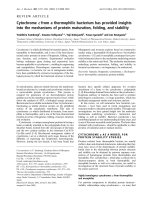Calling C from MATLAB
Bạn đang xem bản rút gọn của tài liệu. Xem và tải ngay bản đầy đủ của tài liệu tại đây (74.66 KB, 8 trang )
53
example (sparse matrices are discused in Chapter 15).
Try:
A = sparse(A) ;
tic ; B = ddom(A) ; toc
tic ; B = ddomloops(A) ; toc
Since not every loop can be accelerated, writing code that
has no
for
or
while
loops is still important. As you
become practiced in writing without loops and reading
loop-free MATLAB code, you will also find that the
loop-free version is often easier to read and understand.
If you cannot vectorize a loop, you can speed it up by
preallocating any vectors or matrices in which output is
stored. For example, by including the second statement
below, which uses the function
zeros
, space for storing
E
in memory is preallocated. Without this, MATLAB
must resize
E
one column larger in each iteration, slowing
execution.
M = magic(6) ;
E = zeros(6,50) ;
for j = 1:50
E(:,j) = eig(M^j) ;
end
9. Calling C from MATLAB
There are times when MATLAB itself is not enough.
You may have a large application or library written in
another language that you would like to use from
MATLAB, or it might be that the performance of your M-
file is not what you would like.
MATLAB can call routines written in C, Fortran, or Java.
Similarly, programs written in C and Fortran can call
54
MATLAB. In this chapter, we will just look at how to
call a C routine from MATLAB. For more information,
see
Help
:
MATLAB
:
External
Interfaces
, or see the
online MATLAB documents External Interfaces and
External Interfaces Reference. This discussion assumes
that you already know C.
9.1 A simple example
A routine written in C that can be called from MATLAB
is called a MEX-file. The routine must always have the
name
mexFunction
, and the arguments to this routine
are always the same. Here is a very simple MEX-file;
type it in as the file
hello.c
in your favorite text editor.
#include "mex.h"
void mexFunction
(
int nargout,
mxArray *pargout [ ],
int nargin,
const mxArray *pargin [ ]
)
{
mexPrintf ("hello world\n") ;
}
Compile and run it by typing:
mex hello.c
hello
If this is the first time you have compiled a C MEX-file
on a PC with Microsoft Windows, you will be prompted
to select a C compiler. MATLAB for the PC comes with
its own C compiler (
lcc
). The arguments
nargout
and
nargin
are the number of outputs and inputs to the
function (just as an M-file function), and
pargout
and
pargin
are pointers to the arguments themselves (of type
55
mxArray
). This
hello.c
MEX-file does not have any
inputs or outputs, though.
The
mexPrintf
function is just the same as
printf
.
You can also use
printf
itself; the
mex
command
redefines it as
mexPrintf
when the program is compiled
with a
#define
. This way, you can write a routine that
can be used from MATLAB or from a stand-alone C
application, without MATLAB.
9.2 C versus MATLAB arrays
MATLAB stores its arrays in column major order, while
the convention for C is to store them in row major order.
Also, the number of columns in an array is not known
until the mexFunction is called. Thus, two-dimensional
arrays in MATLAB must be accessed with one-
dimensional indexing in C (see also Section 5.6). In the
example in the next section, the
INDEX
macro helps with
this translation.
Array indices also appear differently. MATLAB is
written in C, and it stores all of its arrays internally using
zero-based indexing. An
m
-by-
n
matrix has rows
0
to
m-
1
and columns
0
to
n-1
. However, the user interface to
these arrays is always one-based, and index vectors in
MATLAB are always one-based. In the example below,
one is added to the
List
array returned by
diagdom
to
account for this difference.
9.3 A matrix computation in C
In Chapters 7 and 8, you wrote the function
ddom.m
.
Here is the same function written as an ANSI C MEX-
file. Compare the
diagdom
routine with the loop-based
56
version
ddomloops.m
in Section 8.6. MATLAB
mx
and
mex
routines are described in Section 9.4.
#include "mex.h"
#include "matrix.h"
#include <stdlib.h>
#include <float.h>
#define INDEX(i,j,m) ((i)+(j)*(m))
#define ABS(x) ((x) >= 0 ? (x) : -(x))
#define MAX(x,y) (((x)>(y)) ? (x):(y))
void diagdom
(
double *A, int n, double *B,
double tol, int *List, int *nList
)
{
double d, a, f, bij, bii ;
int i, j, k ;
for (k = 0 ; k < n*n ; k++)
{
B [k] = A [k] ;
}
if (tol < 0)
{
tol = 100 * DBL_EPSILON ;
}
k = 0 ;
for (i = 0 ; i < n ; i++)
{
d = B [INDEX (i,i,n)] ;
a = ABS (d) ;
f = 0 ;
for (j = 0 ; j < n ; j++)
{
if (i != j)
{
bij = B [INDEX (i,j,n)] ;
f += ABS (bij) ;
}
}
if (f >= a)
{
List [k++] = i ;
bii = (1 + tol) * MAX (f, tol) ;
if (d < 0)
{
57
bii = -bii ;
}
B [INDEX (i,i,n)] = bii ;
}
}
*nList = k ;
}
void error (char *s)
{
mexPrintf
("Usage: [B,i] = diagdom (A,tol)\n") ;
mexErrMsgTxt (s) ;
}
void mexFunction
(
int nargout, mxArray *pargout [ ],
int nargin, const mxArray *pargin [ ]
)
{
double tol, *A, *B, *I ;
int n, k, *List, nList ;
/* get inputs A and tol */
if (nargout > 2 || nargin > 2 || nargin==0)
{
error ("Wrong number of arguments") ;
}
if (mxIsSparse (pargin [0]))
{
error ("A cannot be sparse") ;
}
n = mxGetN (pargin [0]) ;
if (n != mxGetM (pargin [0]))
{
error ("A must be square") ;
}
A = mxGetPr (pargin [0]) ;
tol = -1 ;
if (nargin > 1)
{
if (!mxIsEmpty (pargin [1]) &&
mxIsDouble (pargin [1]) &&
!mxIsComplex (pargin [1]) &&
mxIsScalar (pargin [1]))
{
tol = mxGetScalar (pargin [1]) ;
}









